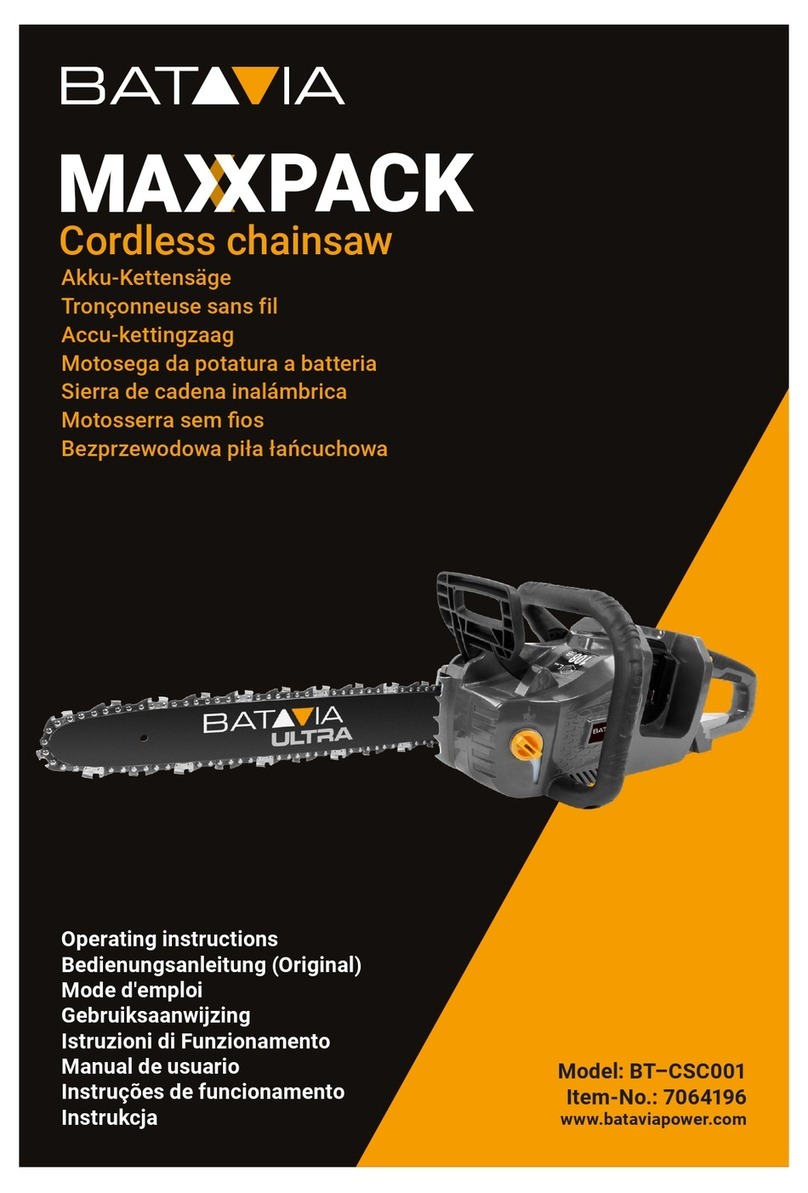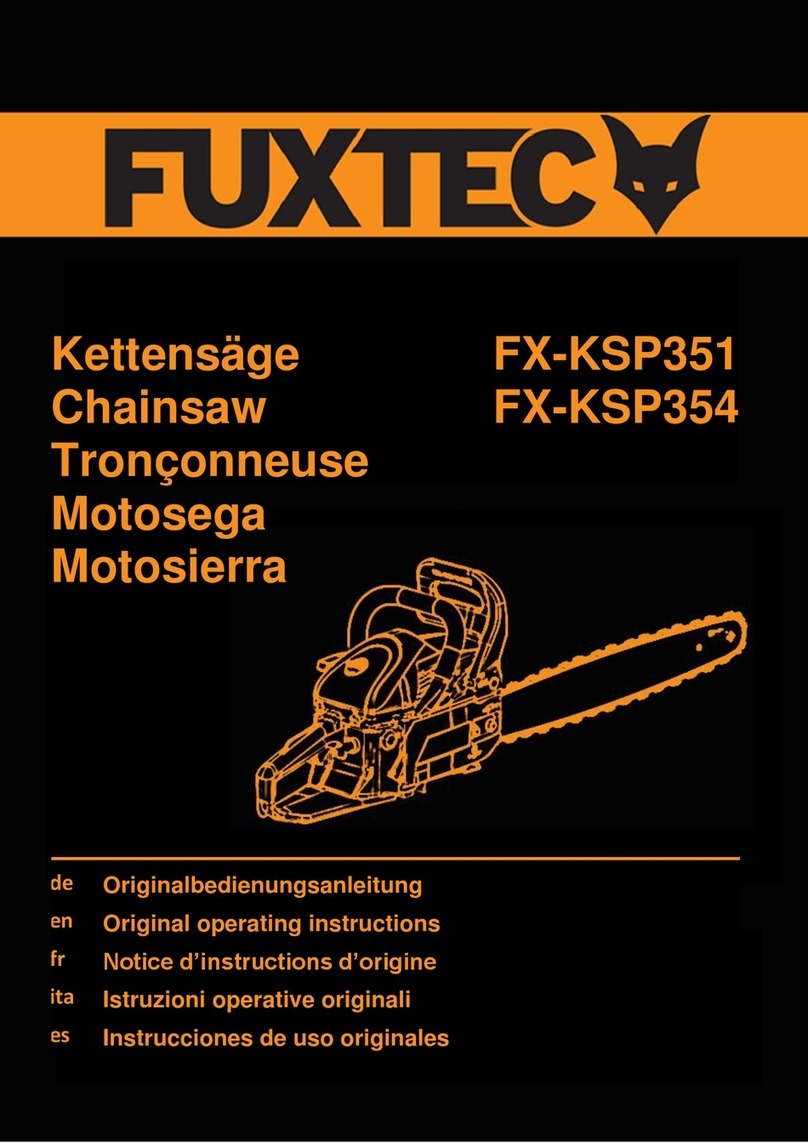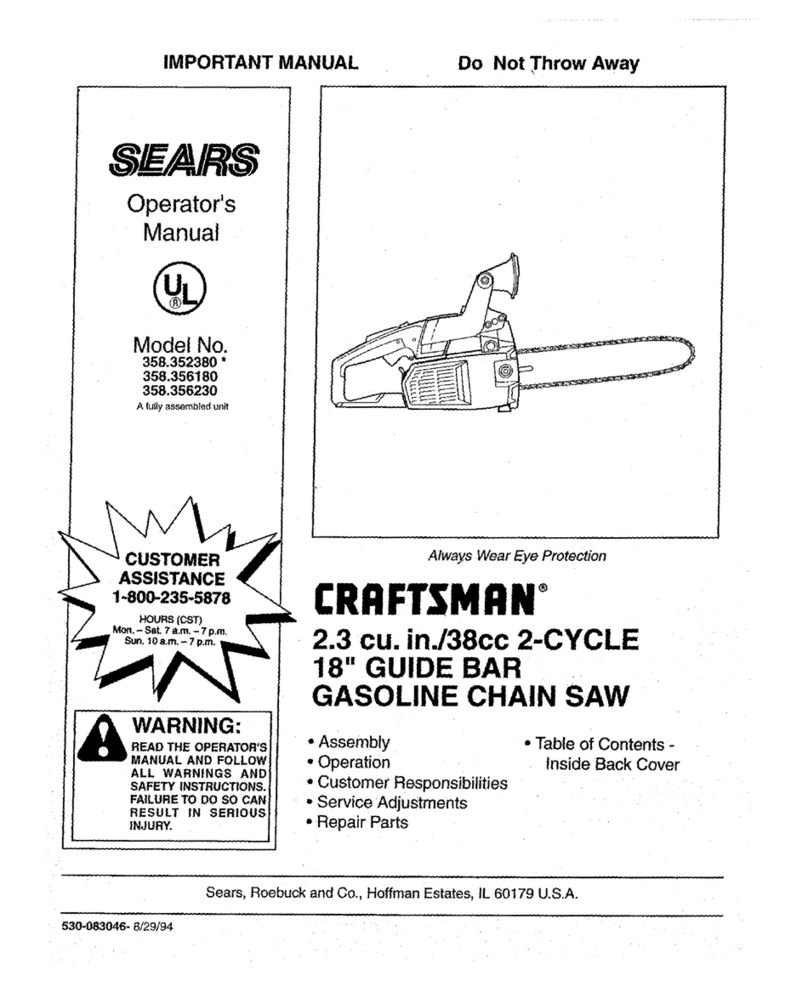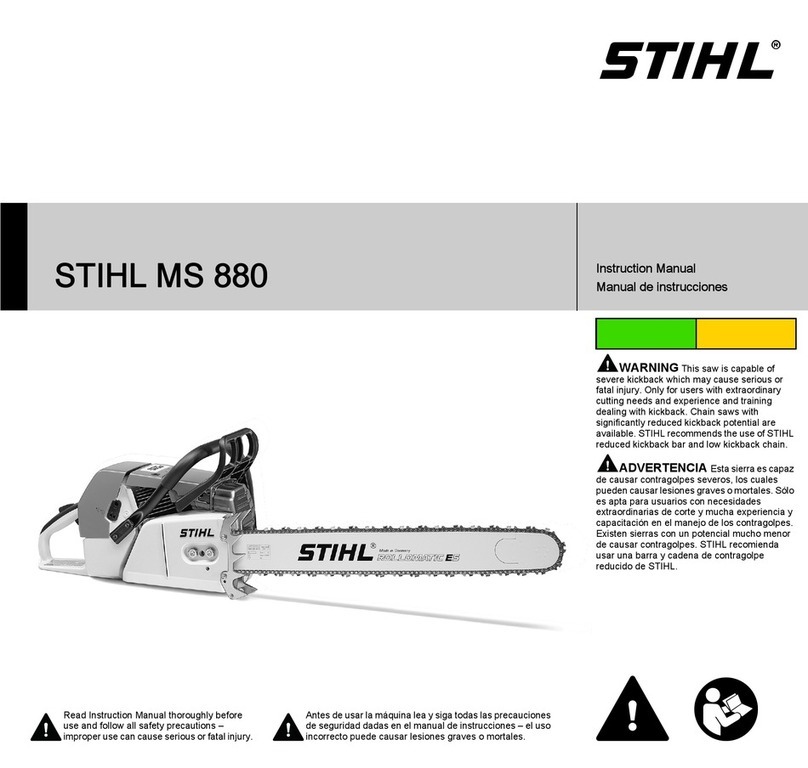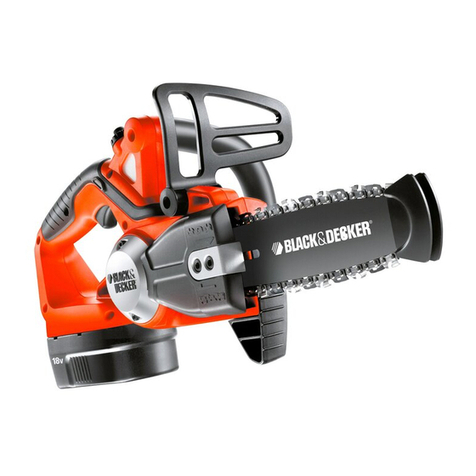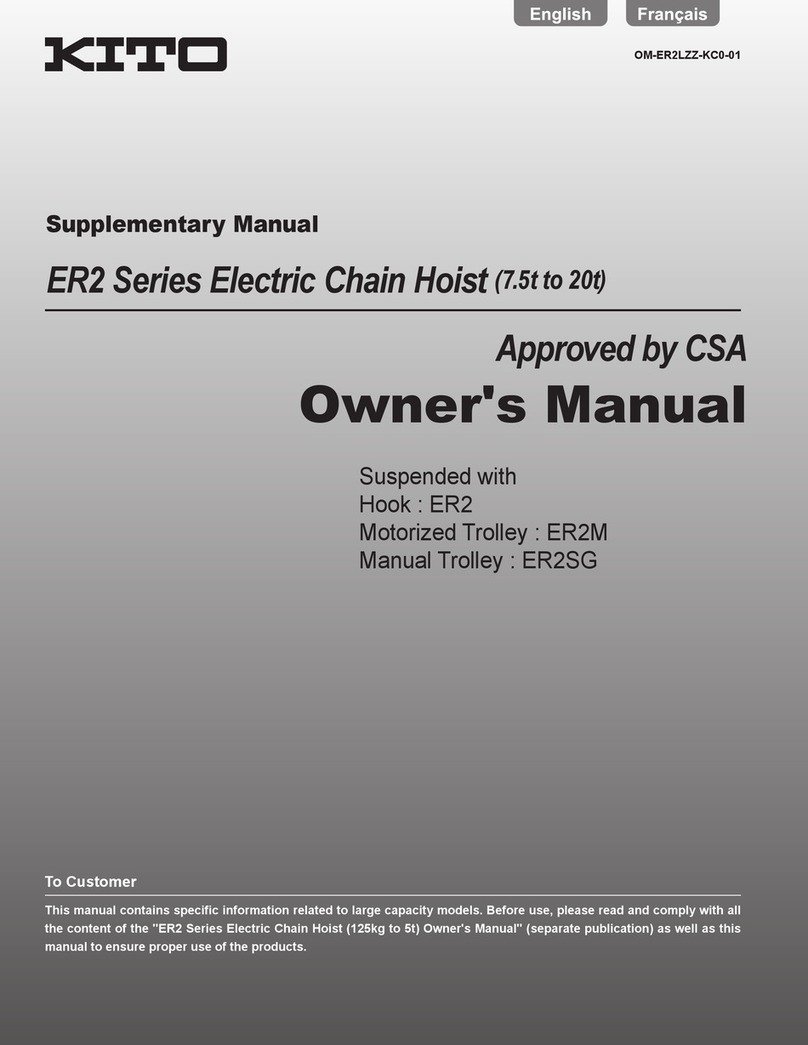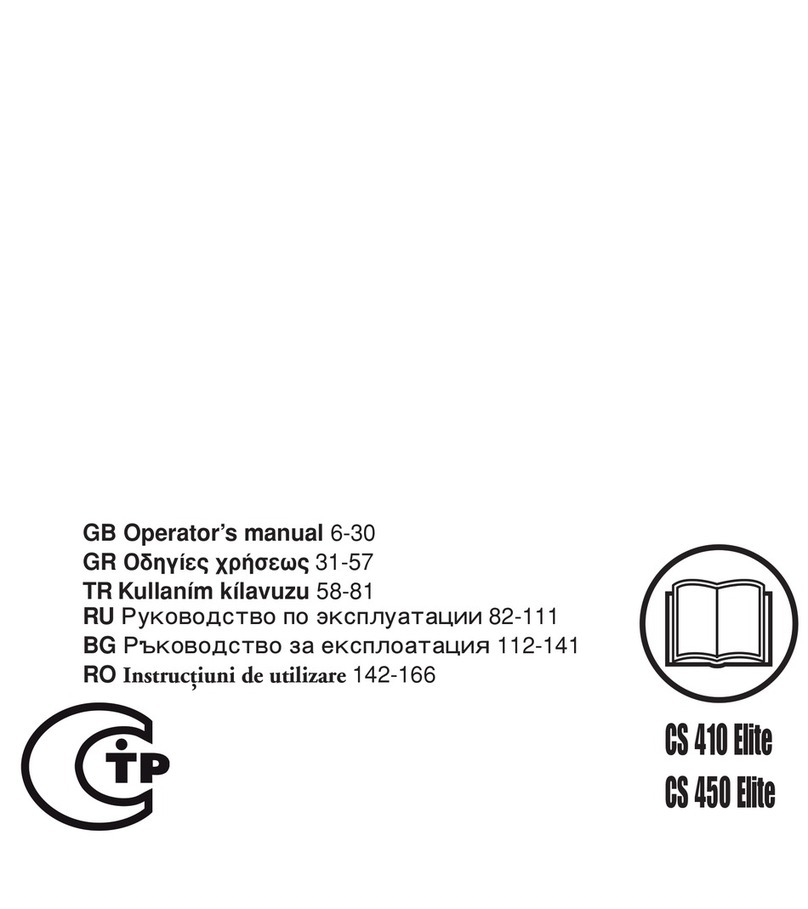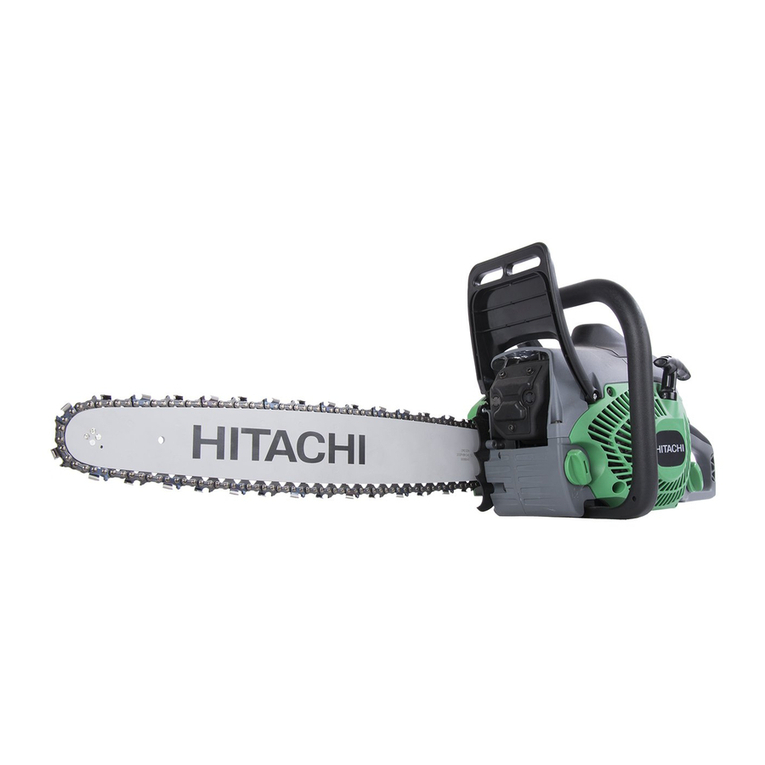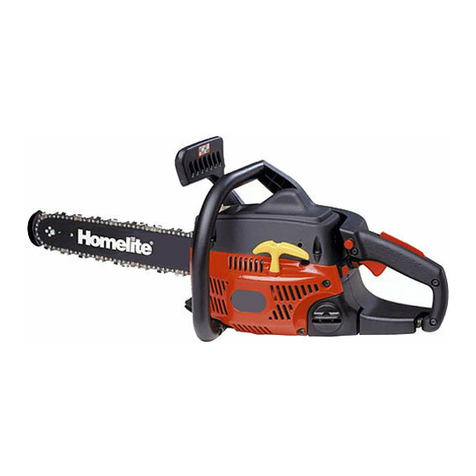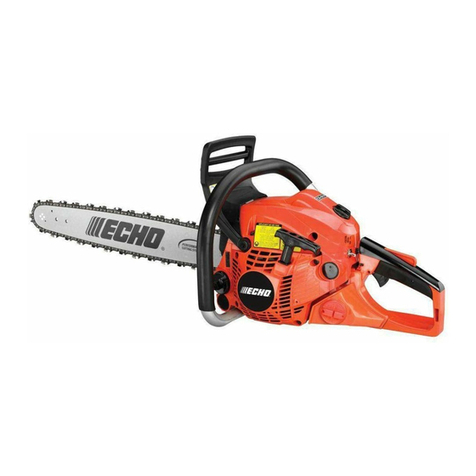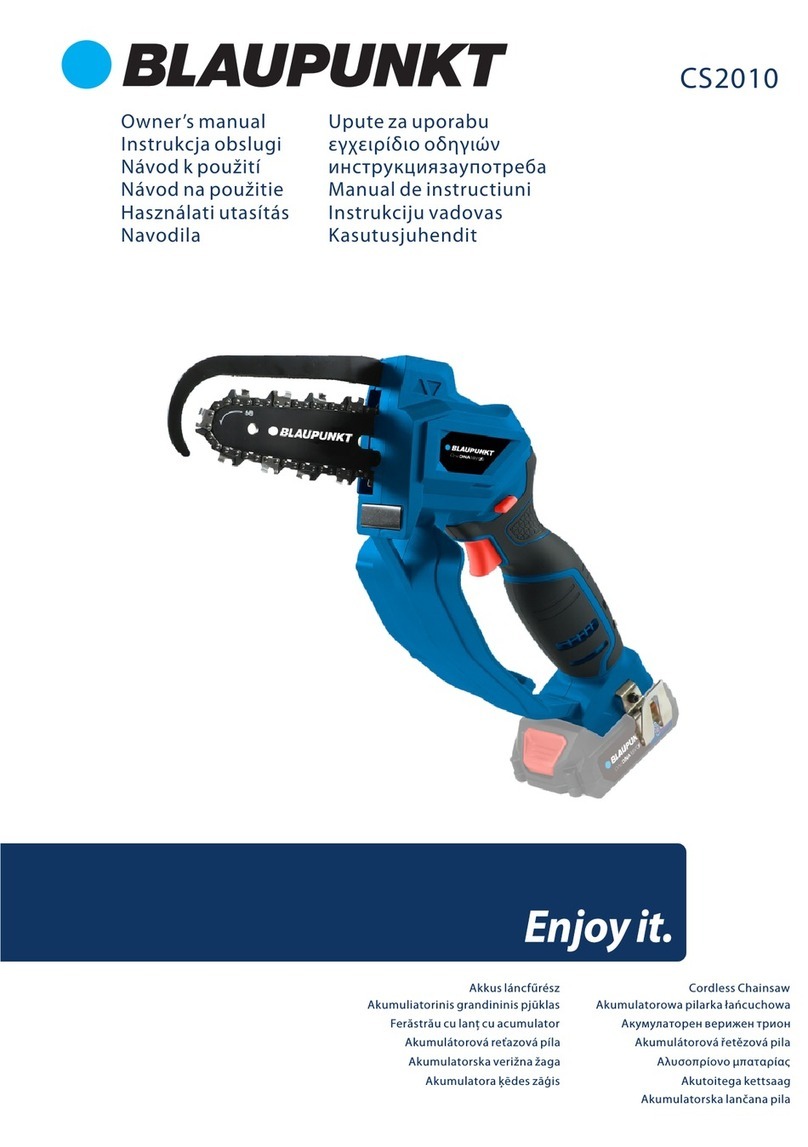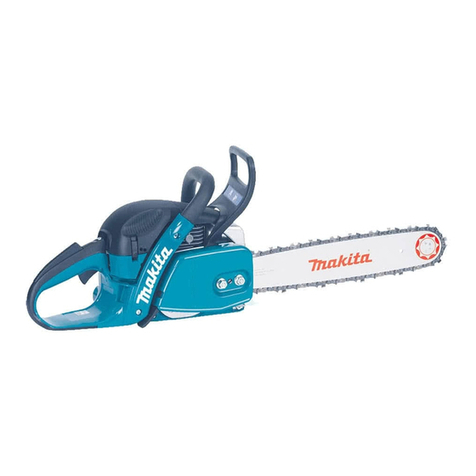Deli DLYD-58-A1 User manual

Instruction manual
Gasoline chainsaw DL585020/DL585022

1. Schematic diagram of gasoline chainsaw .................................................................. 1
2. Safety Precautions..................................................................................................... 1
3. Precautions before use .............................................................................................. 8
4. Chainsaw safety features........................................................................................... 11
5. Assembly of guide plate and chain............................................................................. 12
6. Start and stop engine................................................................................................. 14
7. Maintenance............................................................................................................... 15
8. Maintenance interval.................................................................................................. 19
9. Product Parameters ................................................................................................... 20
10. Description of accessories ....................................................................................... 20
11. General failures and troubleshooting........................................................................ 21
Warranty card

1
1 Schematic diagram of gasoline chainsaw
This schematic diagram is for reference only
Serial
number
Name
Serial number
Name
①
Guide plate
⑥
Air door switch
②
Chain
⑦
Main handle
③
Baffle
⑧
Switch
④
Front handle
⑨
Fuel filling port
⑤
Air filter cover
⑩
Chain oil filling port
2 Safety precautions
Warning
This chainsaw is specially designed for tree maintenance and trimming protection. All operations with
this chainsaw can only be performed by properly trained personnel. Please follow all relevant
materials, procedures and recommendations from relevant professional organizations/institutions,
otherwise there may be a high risk of accidents! We recommend that you should use the lift platform
(lift platform vehicle, lifter) for tree sawing operations. Rappel is very dangerous, requiring special
training! Operators should be trained in and familiar with safe use of equipment and operations and
climbing techniques! When working in trees, be sure to use proper protective belt, rope and safety
hooks, and use restraints for both the operator and chainsaw!

2
General precautions
To ensure proper operations, users must read this manual and familiarize themselves with features of
the chainsaw. If user does not have a good grasp of the contents of the instruction manual, he or
other person may be in danger due to improper operation.
If you want to lend this chainsaw, only lend it to someone who is trained and experienced in the use
of tree trimming chainsaws. When lending, it is necessary to hand over the instruction manual to the
borrower.
Children and minors under the age of 18 may not operate chainsaws, and those over the age of 16
may use the chainsaw for training under the supervision of qualified trainers.
Be especially careful when operating the chainsaw.
You can only operate the chainsaw when you are in good physical condition, and if you are very tired,
you will lack concentration. Be especially careful at the end of a day's work. All work should be done
calmly and carefully. Users should be responsible to others.
Do not use the machine after drinking alcohol or taking psychotropic narcotics or drugs that may
affect the nerve system.
When working in inflammable environment or in a condition where there has been no rain for a long
time, a fire extinguisher must be available nearby (fire danger).
National regulations may restrict the use of the machine. Follow the chainsaw use regulations of your
country.
Protective equipment
To avoid injury to the head, eyes, hands and feet and to protect hearing, the following protective
equipment must be used during the operation of the chainsaw:
The type of clothing should be appropriate, i.e. it should fit snugly and will not interfere with your
movement. Do not wear jewelry or clothing that may get caught by bushes or shrubs. If you have
long hair, be sure to wear a hairnet!
Wear a helmet whenever you use a chainsaw, check it regularly for any damage, and replace the
helmet at least every five years. Use only approved proper protective helmets.
The mask (or goggles) of the protective helmet will keep the chainsaw and sawdust out. Wear
goggles or a mask to protect your eyes during chainsaw operation.
Wear appropriate noise protection equipment (ear muffs or earplugs, etc.).
Always wear a safety jacket when standing on a lift platform (lift platform vehicle, lifter), a platform
mounted on a ladder, or when climbing using a sling.
Wear gloves and anti-skid steel toe safety shoes at all times during chainsaw operation.

3
Fuel/adding fuel
Please shut off the engine before fueling the chainsaw.
Do not smoke or work near an open flame.
Wait for the engine to cool down before fueling.
Fuel may contain harmful substances. Eyes and skin should not come into contact with mineral oil
products. Wear protective gloves, clean and change protective clothing frequently when fueling. Do
not inhale fuel vapor.
Do not spill fuel or oil. Clean the chainsaw immediately when fuel or oil is spilled out. Fuel should not
come into contact with clothing. If your clothing comes into contact with fuel, replace it immediately.
Make sure no fuel or chain oil seeps into the soil (Take care to protect the environment). It is
recommended to use an appropriate base under the chainsaw when refueling.
Refueling is not allowed in enclosed rooms. Fuel steam will accumulate near the ground (risk of
explosion).
Be sure to tighten screw caps on fuel tank and chain oil tank.
Before starting engine, change position (at least 3 meters away from refueling position)
Fuel must not be stored indefinitely, just buy enough for recent use.
Use only approved and marked containers for the transport and storage of fuel and chain oil. Make
sure that children cannot access fuel and chain oil.
Put into operation
Don't work alone. Someone must be nearby in case of emergency
Ensure that no children or other persons are in the work area. Also watch out for any animals in the
work area.
Before starting work, chainsaw must be checked to ensure that the function is normal and can be
operated safely according to regulations. Pay special attention to ensure that the function of the chain
brake is normal, the guide plate is fixed properly, the chain tension is normal, the chainsaw guard is
firmly installed, the throttle trigger is flexible and the function of the trigger lock is normal, the handle
is clean and dry, and the function of ON/OFF switch is normal.
Only when the chainsaw is fully assembled can it be put into operation. Do not use a chainsaw that is
not fully assembled.
Make sure you stand steady on your feet before starting your chainsaw.

4
Only follow the instructions in this manual when starting using the chainsaw; other methods are not
allowed.
When starting the chainsaw, it must be well supported and firmly held, the guide plate and chain must
not touch anything.
When working with the chainsaw, always hold it with both hands, with the right hand holding the back
handle and the left hand holding the front handle. One-handed chainsaw operations are extremely
dangerous because the chainsaw may fall and you lose control of it after completing the cut (with a
high risk of injury). In addition, you can not control the recoil of the operation with one hand.
Note: The chainsaw will continue to run for a short period of time (idle running) after the throttle
trigger is released.
Keep your feet safe and pay attention to the operating environment.
When using chainsaws, ensure that no exhaust gases are inhaled and do not work in enclosed
rooms (there is a risk of poisoning).
If you notice any change in the operation of the chainsaw, shut it off immediately.
When checking the chain tension, tightening the chain, replacing the chain or troubleshooting, the
engine must be shut off
If the chainsaw touches rocks, nails or other hard objects during operation, immediately shut off the
engine and check the chainsaw
Turn off the chainsaw and put it down when you stop working or leave your working position to avoid
endangering others.
Do not place an overheated chainsaw on hay or any flammable object. The muffler is very hot, (there
is a risk of fire).
Note: After stop working, oil dripping from the saw chain or guide plate can contaminate the soil.
A suitable base should always be used.
Recoil force
There is a danger of recoil when working with chainsaws.
Recoil occurs when the end of the guide plate accidentally touches trees or other hard objects.
The chainsaw chain may slide to one side or bounce up before it makes a cut (Note: chainsaw recoil
is extremely dangerous).
This causes the chainsaw to be thrown back toward the user with great force and out of control, there
is a risk of injury!
To prevent recoil, please follow these rules:
Only specially trained personnel can perform penetration cutting, that is, pierce through logs or wood
with the tip of saw chain!
Always look at the end of the guide plate. Be careful when continuing the cutting you have already
begun.

5
The chain must run at the beginning of the cut.
Make sure the chain is properly ground. Pay particular attention to the height of the depth limiter.
Do not cut more than one branch at a time. When cutting a branch, be sure not to touch other
branches.
When cross-cutting a trunk, be careful to remove any other trunk next to it.
Work behavior/work method
Use the chainsaw only in conditions with good light and visibility. Be careful of slippery or wet areas
and watch out for ice and snow (risk of slipping). When working on newly peeled trees, the risk of
slipping is extremely high.
Do not work on unstable surfaces. Make sure the work area is free of obstables, because there is a
risk of tripping. Keep your feet safe at all times.
Never cut on above shoulder height.
Do not cut while standing on a ladder.
Operators should not climb trees without proper restraints on themselves and their chainsaws. We
recommend that you should use the lift platform (lift platform vehicle, lifter) for operation
Do not overtilt your body while working.
The guide chainsaw should ensure that no part of your body is within the extended turning range of
the chain.
Chainsaws can only be used to cut wood
Do not let it touch the ground while the chainsaw is still running.
Do not use chainsaws to raise or remove wood or other objects.
Remove any foreign object found in the work area, such as gravel, stones and nails. Foreign objects
can damage chainsaws and cause dangerous recoil.
Use a safe support when sawing pre-cut logs. Do not fix the workpiece with your feet, nor allow
others to hold or fix it.
When cutting down or cross-cutting trees, spiked bumper must be used.
Fix round wood to prevent rolling.
Hold the chainsaw firmly and hold it in place to avoid slipping or recoil when the chainsaw begins to
cut.
At the end of the cut, the chainsaw will "drop" suddenly, maintain its balance carefully.
Take wind direction and speed into account when working. Carefully avoid sawdust and oil mist from
chainsaw operations.
Do not touch the chain of the chainsaw immediately after finishing the cutting operation. The chain
can be very hot and contact can cause burns.
Before cross-cutting the wood, keep the front end of the chainsaw firmly in contact with the log. Only
in this way can you cut the log while the chain is running. To do this, hold the rear handle to raise the
chainsaw and hold the tubular handle to guide the chainsaw.

6
Rotate around the front end of the machine. Keep gently pressing down on the tubular handle while
pulling the chainsaw backwards. Insert the front end deeper and raise the rear handle again.
When logs must be cut through or cross-cutting should be performed, it is strongly recommended that
only trained personnel can perform the operation.
Every time you remove a chainsaw from the wood, it must be running.
When performing multiple cuts, the throttle trigger must be released between two cuts.
Care must be taken when cutting thin boards. Pieces of wood may be dragged forward (risk of injury).
When cutting with the top of the guide plate, the chainsaw may be pushed in the user's direction if the
chain is caught. For this, the lower part of the guide plate should be used whenever possible. So, the
chainsaw will push away from you.
If the log is under pressure, cut on the pressure side first. Then, crosscuts can be performed on the
pressure side. This prevents the guide plate from being clamped tightly.
Crown removal and logging techniques
Note:
Personnel who remove crowns or cut branches must be specially trained. There is a high risk of
injury.
When cutting branches, the chainsaw should be supported on the tree trunk. Do not use the end
of the guide to cut (there is a risk of recoil).
Note the direction of the force on the branch. Do not cut branches from below.
Do not stand on a trunk and perform cutting work.
Before removing the crown of the tree
a) Only those who are actually involved in crown removal are allowed to remain in the work area.
b) Each personnel involved can step back smoothly without tripping (personnel should retreat back
diagonally, i.e. at a 45° angle).
c) The base of the trunk is free of foreign matter, grass and branches. Keep your feet safe (there is
a risk of tripping).
d) The next working location must be at least 21/2 tree length apart (16). Before cutting down a
tree, check the fall direction to make sure there are no other person or objects within 21/2 tree
length
Judge logging environment
From overhanging direction, loose or dry branches, tree height, natural overhanging, is the tree
rotten?
Consider wind direction and speed. Do not log in the event of high winds. Be careful to avoid
sawdust from chainsaw operations (pay attention to wind direction)!

7
Trunk notching:
The notch determines the fall direction and the tree needed to be guided. The notch in the trunk is
perpendicular to the fall direction and goes deep about 1/3 to 1/5 of the diameter of the trunk.
Perform cutting near the ground.
When correcting the notch, always correct the entire width of the notch.
Over the bottom edge of the notch, cut down the tree. The cut must be completely horizontal. The
distance between the two cuts must be about 1/10 of the diameter of the trunk.
Do not cut through the material between the two cuts, otherwise the tree will fall uncontrollably.
Insert the cutting wedge in time.
Only plastic or aluminum wedges can be used to secure the cut. Do not use iron wedges. If the
chainsaw hits an iron wedge, the chain can be severely damaged or worn.
When cutting down trees, always stand on the side of fallen trees.
Watch out for falling branches when retreating after cutting.
When working on a slope, the chainsaw user must stay above or on the side of the trunk to be
cut or fallen tree.
Watch out for tree trunks that may roll toward you.
Transportation and storage
During operation, when changing position, close the chainsaw and start the chain brake to prevent
the chain from starting accidentally.
Never carry or transport chainsaw while the chain is running.
When transporting chainsaws over long distances, the guide plate cover provided with the chainsaw
should be covered.
Hold the front handle when carrying a chainsaw. The guide plate faces backward. Avoid contact with
mufflers (risk of burns).
When transporting chainsaws by car, be sure to secure the chainsaw firmly to avoid fuel or chain oil
leakage.
Store chainsaws securely in a dry location. It should not be stored outdoors. Keep chainsaws away
from children.
Fuel and oil tanks must be completely emptied before chainsaws are stored for long periods of time
or before transportation.
Perform cleaning and care before storage.
Maintenance
Turn off the chainsaw before performing maintenance work.
Always check the operating safety of the chainsaw before starting work, especially the function of the
chain brake. Ensure proper operation and tighten saw chain.
Operate chainsaws only at low noise and low emission levels. To do this, make sure the carburetor is
properly adjusted.

8
Clean your chainsaw regularly
Check the cover of the tank regularly for tightening.
Follow accident prevention regulations issued by trade associations and insurance companies. Do
not make any modifications to the chainsaw as it will put you in danger.
Vibration
Persons with poor blood circulatory function exposed to excessive vibration may result in vascular or
nervous system injury. Vibration may cause the following symptoms in the fingers, hands or wrists:
"slacking" (numbness), tingling pain, tingling sensation, skin color or skin change. If any of these
symptoms occur, seek medical attention!
Reduce the risk of “white fingers” by keeping your hands warm and maintaining chainsaws and
accessories properly.
3 Precautions before use
Warning:
Avoid contact with skin and eyes. Mineral oil products can cause skin degreasing. If skin is exposed
to these substances repeatedly and for a long time, it can dry out the skin. It also may cause a variety
of skin diseases. In addition, allergic reactions can occur. Eyes can be irritated if contacted with oil. If
oil comes into contact with eyes, rinse immediately with water. If eye discomfort persists, seek
immediate medical attention.
Note:
Extreme care should be taken when handling petrol.
Please do not smoke. Tools should be kept away from open flames, sparks or fire disaster (there is a
risk of explosion).
Fuel oil mixture
The tool is powered by an air-cooled two-stroke engine. It runs on a mixture of petrol and two-stroke
engine oil.
The engine is designed to run on unleaded conventional petrol with a minimum octane rating of 90
RON (87 AKI) and with no more than 10% ethanol. If such fuels are not available, fuels with a higher
octane rating can be used.
This has no effect on the engine.
For optimal engine output and to protect the health and safety of you and the environment, only lead-
free fuel can be used.
Use only two-stroke oil or equivalent high quality two-stroke oil, which is designed for air-cooled two-
stroke engines. Mix engine oil with fuel oil.

9
Note:
Do not use pre-mixed fuel at gas stations.
Correct mixing ratio: mix 25 parts gasoline with 1 part two-stroke oil
Note:
Do not add engine oil in excess of the specified amount. The wrong mixing ratio will result in more
contaminating residues. It can also cause the blockage of the exhaust line on the cylinder and
muffler, reducing service performance and excessive fuel consumption.
Fuel storage
The storage life of fuel is limited. The fuel mixture will age as a result of evaporation, especially at
high temperatures. Aged fuel and fuel mixture may cause starting difficulties and damage the engine.
Buy only the amount of fuel that will be consumed in the next few months. Under the condition of high
temperature, the mixed fuel should be used up within 6-8 weeks. Only store fuel in appropriate
containers, i.e. dry, cool and safe locations.
Chain oil
Lubricate the chain and guide plate with oil containing an adhesive additive. Adhesive additives can
prevent the oil from being thrown into the chain too quickly. We recommend using special chain oil or
biodegradable chain oil to protect the environment. Some places even mandate the use of
biodegradable oil which is stable only for a limited period of time. Use within 2 years after production
date (marked on the container).
Important note about the biodegradable chain oil
If you intend to leave the chainsaw unused for a long time, the oil tank should be emptied , and add a
small amount of conventional engine oil (SAE30), and then running for a while, so that you can wash
out all the biodegradable engine oil residue of oil tank delivery system, chain and guide plate. After a
long period of time, excessive number of biodegradable engine oil would leave a sticky residue, and
the oil pump or other parts might be damaged. Do not use waste oil
Waste oil is extremely harmful to the environment.
Waste oil contains a lot of carcinogens.
Residues in waste oil can cause severe wear to the oil pump and saw cutting equipment.
The product warranty will be void for damage caused by use of waste oil or improper chain oil.
Refuel or add chain oil
Warning
Follow safety precautions. When handling fuel, turn off the engine and be more careful.

10
Note
After refueling, clean the area around the tank cover and tank
Follow these steps to add oil or chain oil:
1. Thoroughly clean the area around the fuel tank cover to prevent dust from entering the fuel tank or
engine oil tank.
2. Loosen the cover and add fuel (fuel/oil mixture) to respective oil tanks.
3. Add the oil to the lower level of the neck of the oiler. Be careful not to spill fuel or chain oil!
4. Tighten the cover of the oil tank as tightly as possible by hand.
Lubricate the chain
Warning
Check the chain oil tank only when the engine is closed
The chain oil tank must have sufficient chain oil to provide good lubrication to the chain during
operation. When handling or refueling, check the chain oil level and fuel as needed.
Check chain lubrication
Note
Never use a chainsaw when the chain is not sufficiently lubricated. Otherwise, the service life of the
saw chain and guide plate will be shortened.
Check the oil level in the oil tank and inlet pipe before starting work.
Pay attention to wind direction and avoid unnecessary exposure to oil mist.
Check the oil feed rate according to the following steps:
1. Start the chainsaw
2. Fix the running chainsaw approximately 15cm above the tree trunk or ground (using a suitable
base).
3. If lubrication is sufficient, you can see light oil stains because the oil has been dispersed on the
chain.
Note
After the chainsaw is closed, the remaining chain oil usually drips off the oil feed system, guide plate,
and chain for a while. This is not a product defect. Place the chainsaw on a suitable surface to
prevent other unnecessary pollution.

11
4 Safety function of chainsaw
Warning
Following safety function does not guarantee injury free all the time. The risk of recoil and other
dangerous accidents can only be reduced by using the correct methods and techniques.
Always check the safety protection function before use.
Chain brake
The chain brake is designed to stop the chain in a few tenths of a second.
To engage the chain brake manually, push the front guard forward with your left hand.
To release the chain brake, pull the front guard back.
Note:
Do not accelerate the engine when the chain brake is starting (except for testing).
Always release the chain brake before starting operation
Check chain brake
1. Run the engine at idle speed
2. Hold the chainsaw with both hands. Hold the top handle with right hand and the front handle with
left hand. Make sure the guide plate and chain are not in contact with anything
3. Press the front hand guard plate with the back of your hand until the chain brake engages.
4. Accelerate until the engine reaches full throttle for at least 3 seconds. Make sure the saw chain is
not moving.
5. The engine returns to idle and releases the chain brake
Check brake band
Brake band is behind the guide plate cover. Chain brake wears out after a long time. Inspection and
repair by Deli authorized service center or professional department at least once every 3 months.
Throttle trigger lock
Throttle trigger lock is designed to prevent accidental starting. Pull the throttle trigger only when the
throttle trigger lock is pressed (i.e. when the handle is grasped).
Check throttle trigger lock
After releasing the hand holding the top handle, check to ensure that the throttle trigger lock is
returned to its original position.
Engine stop
Make sure the engine is stopped while operating.

12
Check engine is stopped
Start the engine. Then release the throttle trigger and press the combination switch to the lower
position
Chain lock pin
The chain lock pin is designed to hold the saw chain as it jumps out of the guide plate. The saw chain
will not jump out if it is properly tightened. Check and adjust the tightness of the saw chain regularly
according to the instruction manual.
Check chain lock pin
Check the chain lock pin for damage and secure to the housing.
5 Assembly of guide plate and chain
Warning
Before performing any operation on the guide plate or saw chain, the engine should be shut off and
make sure the cutting tool is stopped
Always wear protective gloves.
Note
Start the chainsaw only after it has been fully assembled and checked
Install guide plate and saw chain
Note
Installation or removal of saw chain should be done in a clean place free of sawdust or other foreign
objects. Place the chainsaw on a stable surface and perform the following steps
FIG. 1
FIG. 2
FIG. 3
FIG. 4
FIG. 5
FIG. 6

13
1. Pull the front hand guard plate to release the chain brake (the guide plate cover cannot be
removed without releasing the chain brake)
2. Loosen the lock nut (FIG. 1)
3. Remove the guide plate cover.
4. Place the guide plate on the bolt rod. (FIG. 2)
5. Check the direction of the saw chain. The arrow of the saw chain must point in the same direction
as the arrow on the saw housing, and then load the chain into the guide slot (FIG. 3).
6. When installing the guide plate cover, you need to align the adjusting pin of the guide plate cover
with the adjusting hole of the guide plate by adjusting screws (FIG. 4)
7. Adjust the tension of saw chain with the flat-head screwdriver provided with the machine. Tighten it
by screwing clockwise and loosen it by screwing counterclockwise. You can just pull 3-4 sections
of the chain out of the guide slot. (FIG. 5)
8. Lock the nut of the guide plate cover with the sleeve provided with the machine. (FIG. 6)
Adjust the tightness of saw chain
Note
If the saw chain is too loose, it will jump out of the guide plate, which represents hazard of an
accident. If the saw chain is too loose, adjust it.
Too tight saw chain can damage itself, wear guide plate, and damage the adjusting screw/dial.
The chain may become loose after a few hours of use. Check the tightness of the saw chain before
use when replacing it or after several hours of operation. Well-adjusted saw chain can achieve better
performance and longer tool service life.
If the chain is against the bottom of the guide plate and can still be easily turned by hand, the tension
of the chain is correct.
Always check the tension of the chain during use. New chains are easy to stretch.
To adjust the tension of the saw chain, perform the following steps
1. Pull the front hand guard plate to release the chain brake
2. Loosen the lock nut a little to loosen the guide plate cover
3. Raise and hold the top of the guide plate slightly
4. Rotate the chain adjusting screw to adjust the tightness of the saw chain.
5. Adjust the tightness of the saw chain until the lower side of the saw chain is loaded into the guide
plate track. When adjusting the tightness of the chain, keep the tip of the guide plate upward.
6. Hold the guide plate gently and tighten the guide plate cover after adjusting the tightness of the
chain. Tighten the lock nut to secure the guide plate cover.
7. Ensure that the saw chain is not loose at the lower side, but should be fitted to the lower side of the
guide plate, and can still be easily turned by hand.

14
Note:
In order to keep the wear of the guide plate consistent, turn the guide plate over to use it when
changing the chain.
6 Start and stop engine
Warning
Do not start the engine until the chainsaw is fully assembled and thoroughly inspected.
Note
Move at least 3 meters away from chainsaw refueling position.
Make sure your feet are steady and place the saw on the ground.
Make sure there is no contact between the guide plate and the saw chain
Please hold the chain brake tightly before starting the engine
Note
Never stretch the rope full
Gently insert the starter handle back into the housing. Otherwise, the released starter handle may
touch your body or not rewind properly
The engine must enter idle immediately after starting. Otherwise the clutch will be damaged.
Start engine
1. Hold the chain brake tightly (push the baffle forward)
2. Hold the front handle firmly with your left hand and press the chain saw toward the ground
3. Place your right knee against the air purifier cover
4. Start the engine according to the environment of the engine.
Cold start
If the engine has not been used before starting, perform the following steps
1. Press the "one" symbol of the switch (FIG. 7)
2. Pull the air door outward (FIG. 7)
3. Pull the starter handle 3-5 times and push back the air door when hearing the starting sound of the
machine
4. Pull the starting handle again to start the machine.
FIG. 7

15
Warm-up
Once the engine starts, hold the front handle and repeatedly press and release the throttle trigger for
several minutes to warm-up the engine.
Once the speed of the engine is stable and can run smoothly from low speed to high speed, the
warm-up is complete.
Hot start
If the engine has just been run and is still warm, restart the engine by pulling the starter handle. If the
engine does not start, follow the cold start procedure.
As soon as the engine starts running, hold the top handle (release the throttle trigger lock while
holding) and pull the throttle trigger slightly, then release.
Stop engine
Release the throttle trigger, press the switch down to the position of "0" to stop.
7 Maintenance
File and file guiding
Use saw chain to grind special round file (optional accessories). Ordinary round file are not suitable.
The diameter of the round file used is 4.0m
The file should be engaged only on cutting tool in the forward stroke. On the return stroke, raise the
file away from the cutting tool.
Grind the shortest cutting tool first. The length of the shortest cutting tool then becomes the standard
for all other cutting tools in the saw chain
Guide file as shown in the figure.
File support (optional accessory) ensures easier file guiding. The correct grinding angle of 30° is
marked on the file support. When using file support, align the mark parallel to the saw chain and limit
the file depth to 4/5 of the file diameter.

16
After grinding the chain, check the cutting depth with the chain meter tool (optional accessories).
Use a special flat file (optional accessories) to file off a small amount.
Trim the front of the depth gauge.
Check the sprocket
Worn sprockets can damage the new saw chain. Do not use new chains on worn sprockets.
Check the pulp wheel before installing the pulp strip of new saw. If there are failures or more than
0.5m of sprocket wear, please contact Deli authorized service center for repair.
Clean air purifier
To clean air purifier, follow these steps
1. Close the air door to prevent dirt or foreign matter from falling into the carburetor.
2. Loosen the screw and remove the cover of the air purifier.
3. Remove the air purifier.
Note
Replace the air purifier immediately if it is damaged.
4. Cover the air inlet hole with your finger to prevent dust or foreign matter from falling into the
carburetor, and then clean the housing under the air purifier with a soft cloth.
Note
When cleaning the air purifier, cover all carburetor openings with a clean cloth to prevent dust or
foreign matter from falling into the carburetor.
5. Tap the air purifier, or clean it with a brush or air compressor to remove the dust.
Note
If the engine does not run well after cleaning, the air purifier should be replaced.
6. If the air purifier is very dirty, use a new air purifier.
7. Perform the above steps in reverse to install the air purifier and the purifier cover.

17
Clean fuel filter
Fuel filter on the suction head of the tubing is used to filter the fuel needed for the carburetor. Perform
regular visual inspections.
1. Open the tank cover and pull out the suction head from the tank hole with a line hook.
2. If the filter is too hard or blocked, please replace it.
3. After inspection, cleaning or replacement, fix the fuel filter on the fuel pipeline with a pipe clamp.
Press the fuel filter completely into the bottom of the fuel tank
Note:
It is recommended to replace the fuel filter at least once every three months to ensure adequate fuel
supply to the carburetor.
Otherwise, insufficient fuel supply may cause engine failure.
Check spark plug
Note
Do not touch the spark plug while the engine is running (there is a risk of high voltage shock).
The distance between the two electrodes of the spark plug should be 0.6m. If the distance is too wide
or too narrow, adjust it. If the spark plug is blocked or contaminated, it should be thoroughly cleaned
or replaced.
Parts cleaning
Wipe with cotton cloth to always keep the engine clean.
Check bolts, nuts and screws.
Check bolts, nuts, etc. Tighten them if needed.
Check the tightness of fuel cover and oil cover. Check for fuel leaks.
Replace damaged parts to ensure safe operation.
Store tools
Note
The engine is still very hot after it has just stopped. When emptying fuel, wait a certain time after
stopping to allow the engine to cool down. Otherwise, the skin may be scalded and/or cause fire

18
When the machine is not in use for a long time, please empty the fuel tank and carburetor, and keep
the machine dry, store it in a clean place.
Biodegradable saw chain oil has a limited shelf life. If the bio-oil is stored for more than two years
after production, the viscosity of the bio-oil increases and may cause damage to the oil pump and
components while lubricating the system.
When saw chain is not used for a long time, please empty the fuel tank and inject a small amount of
engine oil (SAE30)
Run the chain saw slightly to flush out any bio-oil residue in the fuel tank, lubrication system and saw
chain mechanism. While cleaning, place the chainsaw on an appropriate surface.
When the chainsaw is returned to the factory for repair, inject fresh biodegradable chain oil.
Note
When chainsaws are not used, a small amount of chain oil may leak after a period of time. This is
normal, not a failure.
This manual suits for next models
3
Table of contents

